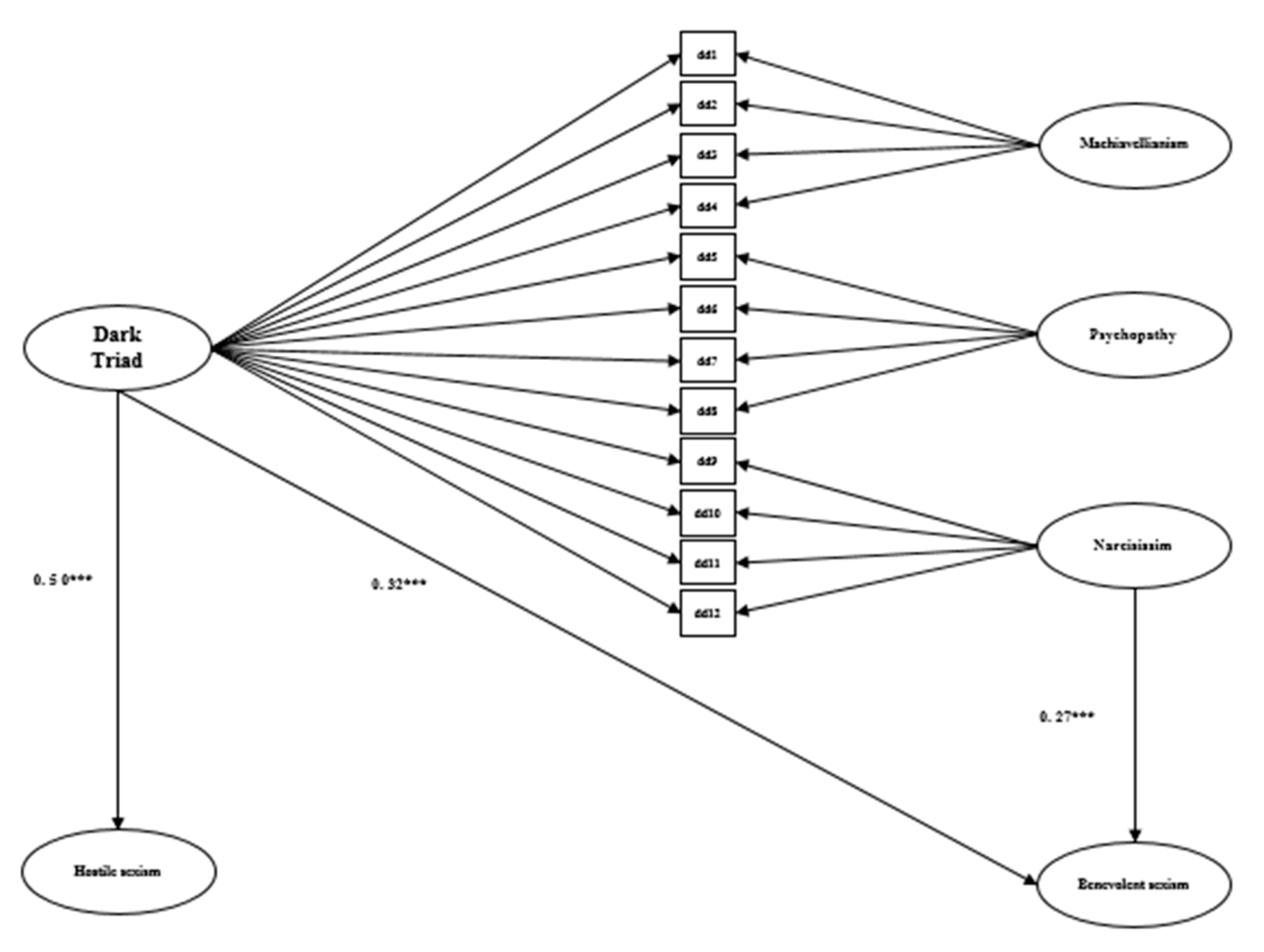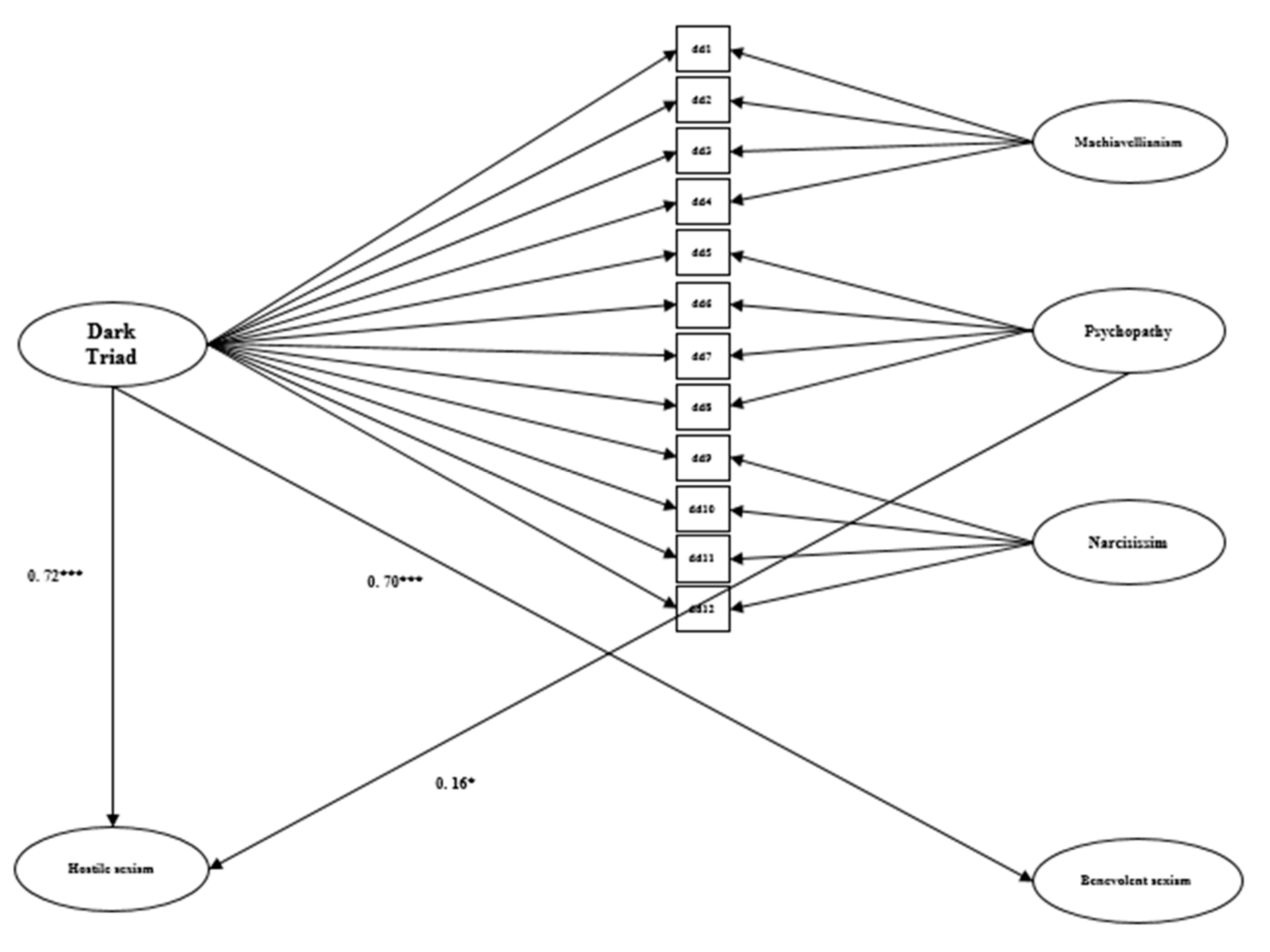Associations between Dark Triad and Ambivalent Sexism: Sex Differences among Adolescents
Abstract
1. Introduction
1.1. Ambivalent Sexism
1.2. Dark Triad Traits
1.3. DT and Ambivalent Sexism
1.4. The Current Study
2. Materials and Methods
2.1. Participants and Procedure
2.2. Measurements
2.3. Data Analysis
3. Results
3.1. Descriptive Statistics and Correlations
3.2. SEM Between DT and Ambivalent Sexism and Differences between Sexes
4. Discussion
4.1. Presence of the DT Traits and Ambivalent Sexism in Adolescents
4.2. Relationships between DT with Hostile and Benevolent Sexism
4.3. Limitations and Future Research
5. Conclusions
Author Contributions
Funding
Acknowledgments
Conflicts of Interest
References
- INE. Estadística de Violencia Doméstica y Violencia de Género [Statistics on Domestic and Gender Violence]; Instituto Nacional de Estadística: Madrid. 2016. Available online: https://www.ine.es/prensa/np972.pdf (accessed on 7 July 2020).
- Bravo, M.D.M.P.; Meseguer, C.B.; Seva-Llor, A.M.; Pina-Roche, F. Conocimientos, actitudes y prácticas de adolescentes españoles sobre la violencia de pareja. iQual. Revista Género Igualdad 2018, 1, 145–158. [Google Scholar] [CrossRef]
- Peña, E.M.; Ramos, E.; Luzón, J.M.; Recio, P. Sexismo y violencia de género en la juventud andaluza: Resultados y recomendaciones [Sexism and gender violence in Andalusian youth: Results and recommendations]; Consejería para la Igualdad y Bienestar Social de la Junta de Andalucía: Sevilla, Spain. 2011. Available online: https://www.observatoriodelainfancia.es/oia/esp/documentos_ficha.aspx?id=3400 (accessed on 7 July 2020).
- Newcomb, T.M.; Rosenberg, M.J.; Hovland, C.I.; McGuire, W.J.; Abelson, R.P.; Brehm, J.W. Attitude Organization and Change: An Analysis of Consistency Among Attitude Components. Am. Sociol. Rev. 1961, 26, 644. [Google Scholar] [CrossRef]
- Allport, G.W. The Nature of Prejudice; Addison-Wesley: Oxford, UK, 1954. [Google Scholar]
- Glick, P.; Fiske, S.T. The Ambivalent Sexism Inventory: Differentiating hostile and benevolent sexism. J. Pers. Soc. Psychol. 1996, 70, 491–512. [Google Scholar] [CrossRef]
- Hellmer, K.; Stenson, J.T.; Jylhä, K.M. What’s (not) underpinning ambivalent sexism?: Revisiting the roles of ideology, religiosity, personality, demographics, and men’s facial hair in explaining hostile and benevolent sexism. Pers. Individ. Differ. 2018, 122, 29–37. [Google Scholar] [CrossRef]
- Rubio-Garay, F.; Carrasco, M.Á.; Amor, P.J.; López-González, M.A. Adolescent dating violence related factors: A critical review. Anu. Psicol. Jurídica 2015, 25, 47–56. [Google Scholar] [CrossRef]
- Travaglia, L.K.; Overall, N.C.; Sibley, C.G. Benevolent and Hostile Sexism and preferences for romantic partners. Pers. Individ. Differ. 2009, 47, 599–604. [Google Scholar] [CrossRef]
- Fernandez, M.L.; Castro, Y.R.; Otero, M.C.; Foltz, M.L.; Lorenzo, M.G. Sexism, Vocational Goals, and Motivation as Predictors of Men’s and Women’s Career Choice. Sex Roles 2006, 55, 267–272. [Google Scholar] [CrossRef]
- Anderson, J.; Cheers, C. Does the Dark Triad Predict Prejudice?: The Role of Machiavellianism, Psychopathy, and Narcissism in Explaining Negativity Toward Asylum Seekers. Aust. Psychol. 2017, 53, 271–281. [Google Scholar] [CrossRef]
- Akrami, N.; Ekehammar, B.; Yang-Wallentin, F. Personality and Social Psychology Factors Explaining Sexism. J. Individ. Differ. 2011, 32, 153–160. [Google Scholar] [CrossRef]
- Jonason, P.K.; Girgis, M.; Milne-Home, J. The Exploitive Mating Strategy of the Dark Triad Traits: Tests of Rape-Enabling Attitudes. Arch. Sex. Behav. 2017, 46, 697–706. [Google Scholar] [CrossRef]
- Paulhus, D.L.; Williams, K.M. The Dark Triad of personality: Narcissism, Machiavellianism, and psychopathy. J. Res. Pers. 2002, 36, 556–563. [Google Scholar] [CrossRef]
- Furnham, A.; Richards, S.C.; Paulhus, D.L. The Dark Triad of Personality: A 10 Year Review. Soc. Pers. Psychol. Compass 2013, 7, 199–216. [Google Scholar] [CrossRef]
- Jonason, P.K.; Webster, G.D.; Schmitt, D.P.; Li, N.P.; Crysel, L. The Antihero in Popular Culture: Life History Theory and the Dark Triad Personality Traits. Rev. Gen. Psychol. 2012, 16, 192–199. [Google Scholar] [CrossRef]
- Jonason, P.K.; Lyons, M.; Baughman, H.M.; Vernon, P.A. What a tangled web we weave: The Dark Triad traits and deception. Pers. Individ. Differ. 2014, 70, 117–119. [Google Scholar] [CrossRef]
- Muris, P.; Merckelbach, H.; Otgaar, H.; Meijer, E. The Malevolent Side of Human Nature. Perspect. Psychol. Sci. 2017, 12, 183–204. [Google Scholar] [CrossRef]
- Gluck, M.; Heesacker, M.; Choi, H.D. How much of the dark triad is accounted for by sexism? Pers. Individ. Differ. 2020, 154, 109728. [Google Scholar] [CrossRef]
- Jonason, P.K.; Lavertu, A.N. Women’s Race-and Sex-Based Social Attitudes. Psihol. Teme 2017, 26, 179–193. [Google Scholar] [CrossRef]
- Yost, M.R.; Zurbriggen, E.L. Gender differences in the enactment of sociosexuality: An examination of implicit social motives, sexual fantasies, coercive sexual attitudes, and aggressive sexual behavior. J. Sex. Res. 2006, 43, 163–173. [Google Scholar] [CrossRef]
- Jonason, P.K.; Valentine, K.A.; Li, N.P.; Harbeson, C.L. Mate-selection and the Dark Triad: Facilitating a short-term mating strategy and creating a volatile environment. Pers. Individ. Differ. 2011, 51, 759–763. [Google Scholar] [CrossRef]
- Jones, D.N.; Neria, A.L. The Dark Triad and dispositional aggression. Pers. Individ. Differ. 2015, 86, 360–364. [Google Scholar] [CrossRef]
- Miller, J.D.; Vize, C.; Crowe, M.L.; Lynam, D. A Critical Appraisal of the Dark-Triad Literature and Suggestions for Moving Forward. Curr. Dir. Psychol. Sci. 2019, 28, 353–360. [Google Scholar] [CrossRef]
- Hepper, E.G.; Hart, C.M.; Meek, R.; Cisek, S.; Sedikides, C. Narcissism and Empathy in Young Offenders and Non-offenders. Eur. J. Pers. 2013, 28, 201–210. [Google Scholar] [CrossRef]
- Jonason, P.K.; Jackson, C.J. The Dark Triad traits through the lens of Reinforcement Sensitivity Theory. Pers. Individ. Differ. 2016, 90, 273–277. [Google Scholar] [CrossRef]
- Pozueco, J.M.; Moreno, J.M.; Blázquez, M.; García-Baamonde, M. Socialized/subclinical psychopaths in intimate partner relationships: Profile, psychological abuse and risk factors. Papeles del Psicol. 2013, 34, 32–48. [Google Scholar]
- Jones, D.N.; Olderbak, S.G. The Associations Among Dark Personalities and Sexual Tactics Across Different Scenarios. J. Interpers. Violence 2013, 29, 1050–1070. [Google Scholar] [CrossRef] [PubMed]
- O’Connell, D.; Marcus, D.K. Psychopathic personality traits predict positive attitudes toward sexually predatory behaviors in college men and women. Pers. Individ. Differ. 2016, 94, 372–376. [Google Scholar] [CrossRef]
- Jones, D.N.; Paulhus, D.L. Differentiating the Dark Triad within the interpersonal circumplex. In Handbook of Interpersonal Psychology: Theory, Research, Assessment, and Therapeutic Interventions; Horowitz, L.M., Strack, S., Eds.; Wiley & Sons: New York, NY, USA, 2011; pp. 249–269. [Google Scholar]
- Maneiro, L.; López-Romero, L.; Gómez-Fraguela, J.A.; Cutrín, O.; Romero, E. Pursuing the Dark Triad. J. Individ. Differ. 2019, 40, 36–44. [Google Scholar] [CrossRef]
- Sobral, J.; Villar, P.; Gómez-Fraguela, J.A.; Romero, E.; Luengo, M. Ángeles Interactive effects of personality and separation as acculturation style on adolescent antisocial behaviour. Int. J. Clin. Health Psychol. 2013, 13, 25–31. [Google Scholar] [CrossRef]
- World Medical Association. Declaration of Helsinki. JAMA 2013, 20, 2191–2194. [Google Scholar]
- Jonason, P.K.; Webster, G.D. The dirty dozen: A concise measure of the dark triad. Psychol. Assess. 2010, 22, 420–432. [Google Scholar] [CrossRef]
- De Lemus, S.; Castillo, M.; Moya, M.; Padilla, J.L.; Ryan, E. Elaboración y validación del Inventario de Sexismo Ambivalente para adolescentes [Elaboration and validation of the Inventory of Ambivalent Sexism for adolescents]. Int. J. Clin. Health Psychol. 2008, 8, 537–562. [Google Scholar]
- Byrne, B.M. Structural Equation Modeling with Mplus: Basic Concepts, Applications, and Programming; Taylor & Francis: New York, NY, USA, 2012. [Google Scholar]
- West, M.A. Moral Evaluation and Dimensions of Violence. Multivar. Behav. Res. 1986, 21, 229–251. [Google Scholar] [CrossRef]
- Koehn, M.A.; Jonason, P.K.; Davis, M.D. A person-centered view of prejudice: The Big Five, Dark Triad, and prejudice. Pers. Individ. Differ. 2019, 139, 313–316. [Google Scholar] [CrossRef]
- Rodríguez-Castro, Y.; Lameiras-Fernández, M.; Carrera-Fernández, M.V.; Vallejo-Medina, P. La fiabilidad y validez de la escala de mitos hacia el amor: Las creencias de los y las adolescentes. Rev. Psicol. Soc. 2013, 28, 157–168. [Google Scholar] [CrossRef]
- Díaz-Aguado, M.J.; Martínez-Arias, R. La Construcción de la Igualdad y la Prevención de la Violencia Contra la Mujer Desde la Educación Secundaria [The Construction of Equality and the Prevention of Violence Against Women from Secondary Education]; Instituto de la Mujer: Madrid, Spain, 2001. [Google Scholar]
- Cutrín, O.; Gómez-Fraguela, J.A.; Sobral, J. Gender Differences in the Influence of Parenting on Youth Antisocial Behavior through Deviant Peers. Span. J. Psychol. 2017, 20, 1–10. [Google Scholar] [CrossRef] [PubMed]
- Jonason, P.K.; Li, N.P.; Buss, D.M. The costs and benefits of the Dark Triad: Implications for mate poaching and mate retention tactics. Pers. Individ. Differ. 2010, 48, 373–378. [Google Scholar] [CrossRef]
- Blinkhorn, V.; Lyons, M.; Almond, L. Drop the bad attitude! Narcissism predicts acceptance of violent behaviour. Pers. Individ. Differ. 2016, 98, 157–161. [Google Scholar] [CrossRef]
- González Moraga, F.R. La tríada oscura de la personalidad: Maquiavelismo, narcisismo y psicopatía. Una mirada evolutiva [The dark triad of personality: Machiavellianism, narcissism, and psychopathy. An evolutionary look]. Rev. Crim. 2015, 57, 253–265. [Google Scholar]
- Cruz, C.E.; Zempoaltecatl, V.; Correa, F.E. Perfiles de sexismo en la ciudad de México: Validación del cuestionario de medición del sexismo ambivalente [Sexism profile in Mexico City: Validation of the Scale of Ambivalent Sexism]. Enseñanza Investig. Psicol. 2005, 10, 381–395. [Google Scholar]


| Range | Males | Females | F | ηp2 | |||
|---|---|---|---|---|---|---|---|
| M (SD) | α | M (SD) | α | ||||
| Machiavellianism | 4–18 | 9.17 (3.73) | 0.81 | 8.35 (3.73) | 0.76 | 4.48 * | 0.01 |
| Psychopathy | 4–15 | 7.34 (3.16) | 0.71 | 6.25 (2.49) | 0.67 | 13.46 ** | 0.04 |
| Narcissism | 4–19 | 10.17 (4.08) | 0.85 | 8.49 (3.78) | 0.80 | 16.74 ** | 0.05 |
| Hostile sexism | 10–37 | 26.81 (10.08) | 0.85 | 18.02 (7.33) | 0.80 | 91.18 *** | 0.20 |
| Benevolent sexism | 10–54 | 28.29 (9.52) | 0.79 | 22.92 (9.40) | 0.83 | 29.53 *** | 0.07 |
| 1 | 2 | 3 | 4 | 5 | 6 | |
|---|---|---|---|---|---|---|
| - | −0.04 | −0.12 | −0.01 | 0.01 | 0.08 |
| −0.04 | - | 0.52 ** | 0.32 ** | 0.22 ** | 0.39 ** |
| −0.06 | 0.57 ** | - | 0.12 | 0.12 | 0.35 ** |
| −0.01 | 0.41 ** | 0.34 ** | - | (0.55 **) | 0.54 ** |
| 0.01 | 0.38 ** | 0.29 ** | 0.26 ** | - | (0.33 **) |
| 0.02 | 0.39 ** | 0.35 ** | 0.52 ** | 0.11 | - |
Publisher’s Note: MDPI stays neutral with regard to jurisdictional claims in published maps and institutional affiliations. |
© 2020 by the authors. Licensee MDPI, Basel, Switzerland. This article is an open access article distributed under the terms and conditions of the Creative Commons Attribution (CC BY) license (http://creativecommons.org/licenses/by/4.0/).
Share and Cite
Navas, M.P.; Maneiro, L.; Cutrín, O.; Gómez-Fraguela, J.A.; Sobral, J. Associations between Dark Triad and Ambivalent Sexism: Sex Differences among Adolescents. Int. J. Environ. Res. Public Health 2020, 17, 7754. https://doi.org/10.3390/ijerph17217754
Navas MP, Maneiro L, Cutrín O, Gómez-Fraguela JA, Sobral J. Associations between Dark Triad and Ambivalent Sexism: Sex Differences among Adolescents. International Journal of Environmental Research and Public Health. 2020; 17(21):7754. https://doi.org/10.3390/ijerph17217754
Chicago/Turabian StyleNavas, María Patricia, Lorena Maneiro, Olalla Cutrín, Jose Antonio Gómez-Fraguela, and Jorge Sobral. 2020. "Associations between Dark Triad and Ambivalent Sexism: Sex Differences among Adolescents" International Journal of Environmental Research and Public Health 17, no. 21: 7754. https://doi.org/10.3390/ijerph17217754
APA StyleNavas, M. P., Maneiro, L., Cutrín, O., Gómez-Fraguela, J. A., & Sobral, J. (2020). Associations between Dark Triad and Ambivalent Sexism: Sex Differences among Adolescents. International Journal of Environmental Research and Public Health, 17(21), 7754. https://doi.org/10.3390/ijerph17217754





